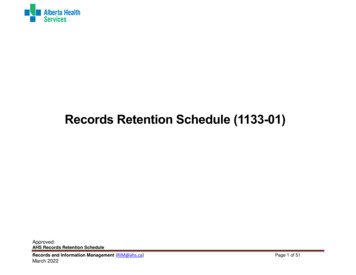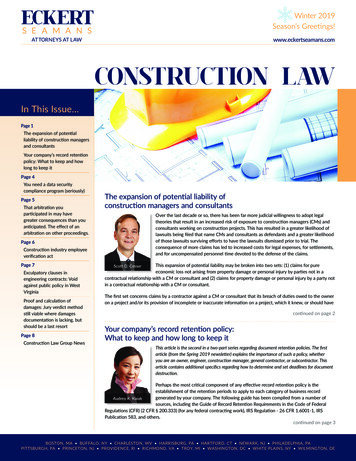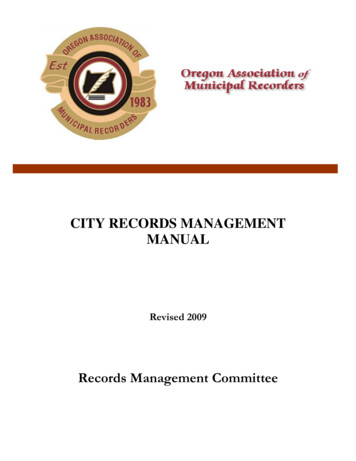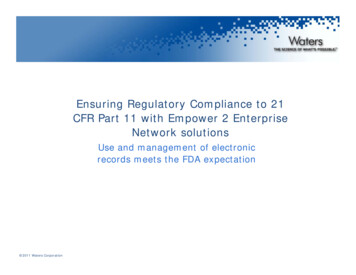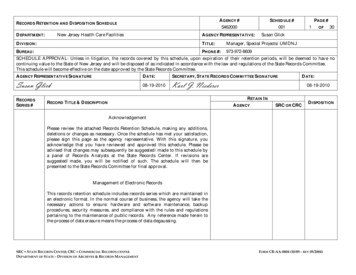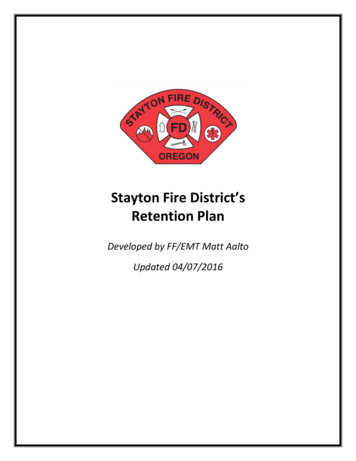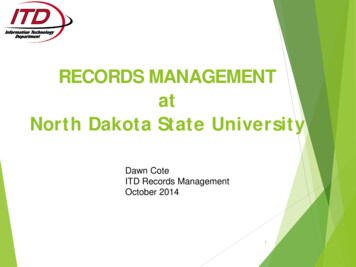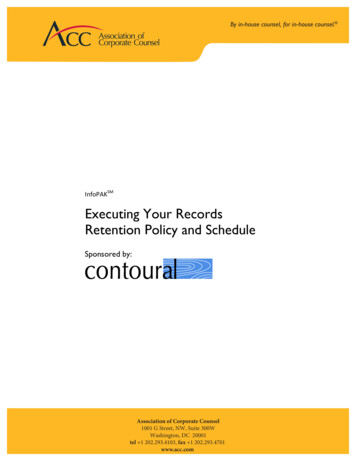
Transcription
ByBy in-housein-house counsel,counsel, forfor in-housein-house counsel.counsel. InfoPAKSMExecuting Your RecordsRetention Policy and ScheduleSponsored by:Association of Corporate CounselAssociation of Corporate Counsel10 ( 4USFFU, NW, Suite 8 1025 Connecticut Avenue, NW, Suite 200Washington, DC 200 Washington, DC 20036 USAtel 1 202.293.4103, fax 1 202.293.4701 tel 1 202.293.4103, fax 1 202.293.4701www.acc.comwww.acc.com
2Executing Your Records Retention Policy and ScheduleExecuting Your Records Retention PolicyandScheduleOctober 2018Provided by the Association of Corporate Counsel1001 G Street, NW, Suite 300WWashington, DC 20001 USAtel 1 202.293.4103fax 1 202.293.4107www.acc.comThis InfoPAK SM details the best practices for executing a Records Retention Policy andSchedule. It includes developing records and information management processes,addressing electronic records through a data placement strategy, creating employeebehavior change management and training programs and dealing with older, legacydocuments. It also discusses offsite records storage and evolving your records program intoa broader and more useful Information Governance program. This InfoPAK is a sequel tothe 2017 ACC InfoPAK developed by Contoural: “Creating Modern, Compliant and Easierto-execute Records Retention Schedules.”The information in this InfoPAK should not be construed as legal advice or legal opinion onspecific facts, and should not be considered representative of the views of Contoural, Inc., ofACC or any of its lawyers or members. This InfoPAK is not intended as a definitivestatement on the subject it covers, but rather to serve as a resource providing practicalinformation to the reader.This material was developed by Contoural, Inc. Contoural, Inc. is the sponsor of theInformation Governance Network and a sponsor of the Legal Operations Network RecordsManagement and Information Governance Foundational Toolkit. For more informationabout the author, visit their website at www.contoural.com or see the “About the Company”section of this document.Contoural and ACC wish to thank members of the Information Governance Network fortheir support in the development of this InfoPAK.Copyright 2018 Contoural, Inc. & Association of Corporate Counsel
3ContentsI.II.Challenges of Executing a Records Retention ScheduleA.Traditional, Paper-Centric Records Practices Don’t Work for Electronic Information5B.Simply Having a Policy Does Not Make Your Program Compliant5C.The Risks of Employee Self-Declaration6D.Companies Need to Adopt Modern Approach to Execution7Getting StartedA.III.IV.V.VI.5Start with an Updated, Modern Records Retention Policy88B.Engage Other Groups When ExecutingC.The Budget Question – Who Should Pay?11D.Determine the Right Records Program Maturity for Your Organization12E.Divide Your Execution into Phases13Three Methods of Executing Records Retention913A.Manual Processes for Records Retention14B.Data Placement Strategy15C.True Autoclassification16D.Creating Records Management Processes and Procedures17Employee Behavior Change Management and Training19A.Records Management Messaging and Communications Strategy20B.Records Management Training20C.Roll-Out22D.Audit23Legacy Paper and Electronic Disposition23A.Defensible Disposition of Unneeded Files and Emails23B.Cleaning Paper Record Storage24C.Why Electronic Defensible Disposition Programs Stall Out24Addressing Offsite Records25A.Top Three Reasons Offsite Storage Costs Are Increasing26B.Reducing Ongoing Storage Costs26For more ACC InfoPAKs, please visit opaklistings.cfm
4Executing Your Records Retention Policy and ScheduleVII.VIII.Upgrading Your Records Program to Information Governance28A.What Is Information Governance?28B.Upgrading to Information Governance28Final Words29IX.About Contoural, Inc.29X.About the Author31XI.Additional Resources32A.ACC InfoPAKs32B.ACC Docket Articles32C.ACC Legal Quick Hits32D.ACC – Webcasts32E.ACC – Information Governance Network Resources32F.Contoural Whitepapers33G.Other Articles33Copyright 2018 Contoural, Inc. & Association of Corporate Counsel
5I. Challenges of Executing a Records RetentionScheduleRecords Management execution is a source of frustration for many companies. They find itdifficult to consistently apply retention, and especially deletion, to their documents and data asprescribed by their records policy and schedule. Instead, this information continues to accumulate,driving up risks and costs. Organizations often become keenly aware of the lack of recordsretention compliance during eDiscovery or while trying to implement a privacy program.Moreover, records retention execution seemingly pits the legal team against employees andbusiness units who often want to adopt a “save everything forever” approach. Perhaps it’s time torethink how organizations execute records management.A. Traditional, Paper-Centric Records Practices Don’t Work forElectronic InformationTraditionally, records retention programs were designed for the retention and disposition of“official” paper records. Executing a records program came down to sorting the right paper intorecord storage boxes, and (sometimes) destroying those boxes once their retention period expired.Yet, as companies move into the digital age, their records management practices do not keep pace.This paper-centric thinking still lives on in many programs: Programs continue to have an emphasis on paper records management, to the exclusionof the majority of records that are created or received in electronic mediaRecords retention is a largely manual processVery few employees actually follow their records retention policy and schedule, and insome cases are not even aware that they actually exist.These older programs, especially in the era of electronic information, not only fail to drivecompliance, but actually hinder it. Worse, the lack of a viable program drives up both offsite paperand electronic storage requirements, increases risks and costs during litigation, and hampersprivacy. A more modern and effective approach is needed.B.Simply Having a Policy Does Not Make Your Program CompliantIn records management, it is tempting for in-house counsel to focus on its area of expertise –creating the “most legally compliant” policy. Sometimes, legal departments segment recordsprograms into policy development and policy execution as separate and exclusive tasks. Whilethey are willing to own policy development, they fall short on policy execution. However, thishands-off or deflected policy approach can come back to haunt the legal group. Often IT orFor more ACC InfoPAKs, please visit opaklistings.cfm
iness units don’t take ownership of policy execution, information accumulates everywhereincreasing costs and risks and lowering compliance.Having a policy in and of itself does not compliance make. Regulators and courts judgecompliance on how well a policy is executed. They ask: What did the organization say it was goingto do (in its written policy)? What are the processes, training, and controls used to execute thepolicy? Were the follow-up and audit procedures properly followed? And, did the policy achieveits intended results? Policy creation, therefore, should have a constant eye on execution. If anorganization cannot execute what is stated in its policy, the policy should be redesigned to do so.This effectiveness assessment “gut check” should serve as a guide throughout the process.While courts and regulators do recognize that records management is an inherently imperfectprocess, they expect reasonable, good faith efforts. Create a policy with clear objectives. Executethe policy with processes, technology, and training. Demonstrate the compliance of the policy withthrough metrics and audits. Show that a plan has been developed and is being executed. Audit theresults and remediate any shortfalls. Not perfect? That’s okay. No one expects it to be perfect. Startwith good and keep moving forward.Figure 1. Courts and Regulators judge program compliance not on the policy but rather howfaithfully the policy has been executed.C.The Risks of Employee Self-DeclarationOne approach to records management compliance is through employee self-certification.Employees are expected to acknowledge their compliance with the records policy, for example, byclicking a link sent in a monthly email, and those who fail to acknowledge it face disciplinaryaction. While Contoural likes the apparent simplicity and ease of this approach, its assessments ofrecords program compliance have shown this type of self-certification does not actually work.Employees tend to follow the process initially, but soon fall behind declaring and retaining theirCopyright 2018 Contoural, Inc. & Association of Corporate Counsel
7records. They still click the link claiming compliance, thinking to themselves they will catch upclassifying all their records or otherwise complying with the policy. They fall farther and fartherbehind. The acknowledgments of compliance continue but they are not matched with actions. Thiscan become a major issue during a regulatory inquiry or any litigation.D.Companies Need to Adopt Modern Approach to ExecutionAs information management has transitioned from paper-based to digital, records managementexecution also needs to be updated to a more modern approach. The key to solving thesechallenges is taking a step back and rethinking how such programs can and should be executed.Traditional Paper-centric ApproachModern Records Management andInformation Governance ProgramMedia-specific approach that addressesmainly paperContent-specific approach capable ofaddressing paper and especially electroniccontentDetailed Records Retention Schedules withhundreds of categoriesCompliant yet “Bigger Bucket” retentioncategories for easier classificationEach employee has their own personalstore of his or her own documents.Valuable information is shared acrossgroups and departmentsDocuments classified for retention periodsDocuments classified for a broaderinformation governance frameworkincluding retention, data security, privacy,and collaborationMany records printed out on paper as theofficial copyMost documents managed in electronicformatInformation stored in difficult to accesslocations, such as offsite storageEmployees and departments have easyaccess to their documents and dataEmployees self-verify complianceRegular system audits ensure policydefensibilityTable 1. Transitioning from a paper-centric records program to a modern, digital and paper-based program.Upgrading records management programs involves creating processes and applying technologythat more easily capture and classify records and documents. There is much less emphasis onmanual processes, and more emphasis on identifying records and high value information.For more ACC InfoPAKs, please visit opaklistings.cfm
Getting StartedBefore launching any new records retention program, three key program elements should beaddressed: (1) ensure an updated and modern records retention schedule is in place; (2) engage theappropriate group of stakeholders; and (3) establish at the beginning of the program who will fundwhat parts.A.Start with an Updated, Modern Records Retention PolicyNote: This section summarizes important attributes of a modern schedule. A detailed overview of this ispresented in ACC’s companion InfoPAK: “Creating a Modern, Compliant and Easier-to-execute RecordsRetention Schedule.”Updating the retention schedule to be modern, compliant and easier to execute is often one of thefirst steps companies take to modernize their program. But, what makes a records retentionschedule modern? How is a schedule properly crafted so it works better in today’s informationenvironment? Through creating, updating and executing hundreds of records retention schedulesover the years, several common attributes have been identified:Compliance. Does the established retention policy and schedule follow all the rules? Immatureretention policies and schedules do not consider the rules, do not provide the legal basis forretention periods and do not mandate disposition of expired information. As a schedule matures,it should address general legal and regulatory requirements, as well as any industry-specificregulations. For global companies, the most mature schedules include country-specific retentionrequirements. This is an elemental requirement of any schedule.Comprehensiveness. Does the established schedule represent all the records in the organization?Companies often try to take short-cuts by copying from industry templates or sample schedulesthat purport to include all records a company in that industry should have. These “out of the box”schedules will typically describe around 80% of a company’s records. They omit, however, the 20%of records that may be atypical for an individual company. Effective schedules are comprehensiveand capture all – both typical and uncommon – record types.Media. Does the schedule address all media formats where records might exist? The oldest (andoften the least mature) schedules concentrate on only paper or a subset of the media present in theorganization. Today, many records – some exclusively – exist in newer media such as email, filesand even social media. Also, do not overlook physical items that might qualify as records: labspecimens at life science companies, or even shoe design samples at shoe manufacturers, are oftenconsidered record types. A more mature schedule includes all media types and will help changethe mindset that a comprehensive schedule only applies to paper records.Clarity. An effective policy and schedule clearly define “What is a Record?” and “What is not aRecord?” Likewise, they detail for employees what records must be kept, and what should bedestroyed. A policy and schedule should be both informative and clear: they should define nonCopyright 2018 Contoural, Inc. & Association of Corporate Counsel
9records and provide examples, while avoiding esoteric acronyms and incomplete definitions.Consensus. An effective schedule should represent a consensus across the organization of whatinformation should be saved and for how long, and what information can be deleted and when.Often, a records initiative is driven by one group within the company. For example, Legal orCompliance might be spearheading the entire project and thus, make little effort to engage otherdepartments. This results in rogue business units who either refuse to follow the schedule or pushback on its requirements. Compliance efforts are often seen as “Legal poking its nose in ourbusiness” or “encroaching on our territory” and therefore are unwelcome.Usability. The most practical schedules provide a “right-sized” approach: just enough information- not too little, not too much. They use a format that is easy to read and is organized in a way thatall employees can follow. A usable schedule follows a “Big Bucket” approach, with a small numberof record categories; rather than a “Small Bucket” approach, with hundreds or even thousands ofrecord line items. Additionally, a usable schedule should be concise – it doesn’t list every singlerecord or example for a particular record category.Integration. A mature retention policy and schedule should be integrated into an overallInformation Governance program, which includes data classification, privacy, informationsecurity, collaboration and litigation readiness. A well-designed schedule should be a useful tool inall these functions. The data classification and privacy components of the company’s InformationGovernance program should leverage the schedule to understand what types of records exist, andif they contain confidential information, privacy or intellectual property that needs to be protected.Defensibility. Retention policies and schedules must be defensible, in the event they must ever bedefended in court or to regulators. Defensibility also means ensuring employees are in complianceand are actually following the policy. If there is a provision in the policy that employees cannotfollow, it should be rewritten to enable compliance.Maintenance. A schedule is a living, breathing document that must be periodically reviewed andupdated- as new record types are created, old record types become obsolete, and legal citationschange - not to mention new recordkeeping regulations that come into play. Schedules should beupdated every 12 to 18 months.Effort put into creating a better schedule with these attributes will pay off many times over duringexecution.B.Engage Other Groups When ExecutingThe second key element to executing an effective program is ensuring that the right stakeholdersare engaged. While the pain of poorly managed information can be particularly acute for in-housecounsel, the temptation to execute these initiatives alone should be avoided. The most effectiveprograms are composed of legal, IT, risk, compliance, security, privacy, records management andbusiness experts. No one person or group has the expertise to address all the functional aspects ofrecords management execution (even the records group), and collectively, a well-established teamwill be better positioned to get the job done.This raises a natural question: how to get other groups to participate in records managementFor more ACC InfoPAKs, please visit opaklistings.cfm
ecution? The fear is that no other groups see this as their problem and getting participation willbe difficult. Interestingly, there are huge non-legal “wins” for a well-functioning records program.The key to building participation is targeting and messaging those wins to the other stakeholders.Table 2 provides a list of relevant messages.StakeholderSample Win and MessagingLegalCompliance with corporate retention and destruction policiesnot only for paper but also email and other electronicdocuments.LitigationSignificantly reduced eDiscovery risks and costs; narrowerlegal holds; early case assessment.PrivacyCompliance with EU Data Protection and US privacyrequirements; easier implementation of cross border controls;easier implementation of EU “Right to Be Forgotten”requirementsComplianceBetter compliance and monitoring of corporate compliancerequirements including FCPA; easier investigationsRecords ManagementControl, management and disposition of paper as well aselectronic informationRisk ManagementBetter overall controls and reporting for IG-related risksIP ManagementBetter collaboration among knowledge workers; easieridentification and support for IP developmentITReduced data storage costs; better use of existing technologies;better and more useful IT servicesData GovernanceBetter protection of privacy; higher data quality; avoid“polluting” data lakesInformation SecurityEasier identification of corporate confidential, as well as othersensitive information; reduced risk of data breachesFacilitiesDecrease in the amount of paper records storageAuditBetter investigation processes; reduced risk of IP breachCopyright 2018 Contoural, Inc. & Association of Corporate Counsel
11HRImproved collaboration among employees; better managementand control against hostile workplace claimsFinancePotentially large cost savings across multiple groups; bettercompliance with SOX and other regulatory requirementsBusiness UnitsIncreased employee productivity; better use and reuse ofinformation; mitigated impact of employee turnoverIndividual EmployeesSaving an average of 2 to 3 hours per week, per employee,searching for informationTable 2. Messages to engage other stakeholders to participate in records management programexecution.Perhaps the biggest “win” will derive from better employee productivity and enhancedcollaboration. Employees can search and locate what they need to improve their job performanceby reducing the time they spend in personal information management (saving and searching foremail, files, and other information). In addition, when a project is finished, an employee leaves, ora group is disbanded, information that may otherwise be isolated on desktops or in personalrepositories can still be leveraged for future business value.C.The Budget Question – Who Should Pay?Sometimes upgrading records management capabilities does require expenditures on technology,outside services, personnel and other areas. One significant roadblock to address early is whichgroup will (and should) fund these efforts. The debate often goes around and around: IT thinksLegal should pay because Legal will benefit from the content management solution. Legal thinksIT should pay because technology is involved. Or is it the business units’ responsibility? One of therisks in engaging a number of stakeholders in this discussion (and understanding their needs) isthat it also creates conflicting expectations about who should pay. There have been situationswhere an archiving system, for example, would have saved a company literally millions of dollars,but the project was stalled due to arguments over who would fund it. The greatest risk is that noone initiates these discussions for fear that speaking up first will somehow tag them as projectfunders.Experience has shown that it is best to get these issues out on the table early. Clearly, recordsmanagement execution does cost money, but it also can save even more. Often when thecommittee highlights the risks of not having a program, senior management will fund or startfunding these programs through other sources. Some organizations have been successful inattaching these initiatives to risks that have been pointed out by the board of director’s auditcommittee. Sometimes a negotiation results in legal paying for the policy and IT paying for thetechnology components. When discussed, what appears to be a budgetary road block can bring anumber of creative funding solutions to light.These discussions should also include a detailed list of cost savings. An effective records programFor more ACC InfoPAKs, please visit opaklistings.cfm
duces costs and risks of eDiscovery, the cost of storage (both online and on-premises) and alsoreduces risks and potential fines for compliance. Perhaps most significant, it can save employeeshours per week in managing information. These savings are material, can be measured, andshould be included in the discussion of who pays.D.Determine the Right Records Program Maturity for Your OrganizationFigure 2. Sports car, sedan or golf cart? Different organizations require different levels of maturity.Target the right level of records management maturity for your organization.Records Management requirements vary widely across industries and even across similarcompanies. Different industries face different records compliance requirements, as well as theamount of records created. Size and geographical distribution also vary widely. Organizationsshould consciously target the appropriate level of maturity for their records program. A feworganizations need a sophisticated and more expensive “sports car” level of program maturity;however, more organizations would be better off with a lower level “sedan” or even “golf cart”level program. The appropriate maturity is based on a combination of factors, includingcompliance requirements, litigation profile, industry practices, company size, culture andbudgetary constraints. It is better to have a well-executed, albeit simpler approach than a morecomplex, difficult, and expensive “sports car” target that spends more time in the repair shop thanbeing driven. Senior managers know this to be the case and savvy records professionals know thattargeting the right level of maturity is key. Make a conscious choice based on these factors. Whenjustifying a program, be sure to explain the choice and the rationale behind it.Copyright 2018 Contoural, Inc. & Association of Corporate Counsel
13E.Divide Your Execution into PhasesThere is a tendency to simply start with a small component of records execution without worryingabout bigger picture details. But even small initiatives run across – and may conflict with – otherprogram elements. Organizations wanting to dispose of files and other unwanted unstructureddata, for example, may start with an electronic data deletion project. However, before this can bedone the records retention schedule may need to be updated. Then someone realizes that the legalhold process should be addressed so information under legal hold is not deleted. Just gettingstarted can be difficult! Avoid creating one single, large project and getting stuck. Rather, take abig picture view and develop a roadmap that divides projects into smaller, more manageablepieces.As the strategy is being developed, consider the timeline in which these projects can be completed.The timeline should factor in competing initiatives, funding, and the speed at which theorganization can absorb change. Some smaller programs can be executed in a quarter or two.Larger and more complex organizations often have records program timelines that may span anumber of years. Perhaps, most importantly, each project or small group of projects should offeran organizational “win” in which the enterprise witnesses the benefits of these types of programs.Having wins early and then throughout the process will help build momentum and buy-in, asopposed to experiencing only one win at the end of a series of long projects.It should be noted that many organizations fear that the day they formally adopt their recordsretention policy and schedule they are under an obligation to fully execute it. This is neitherrealistic nor practical. Records retention and Information Governance programs are best rolled outin phases. After updating their policies, organizations may first address email, then files, thenoffsite records, for example. This “divide and conquer” approach is more doable and leveragesexperience from one medium (email, for example) into the next (attacking file shares). Nor is therean expectation from courts and regulators that policies be fully implemented on Day One. It’s fairto point out “here’s our policy and here’s our roadmap”. Regulators and courts want to, not onlysee the plan, but that it is being executed in a reasonable timeframe. Typically, they want to seeongoing activity quarter after quarter.III. Three Methods of Executing RecordsRetentionWhile there are a variety of methods for executing a records retention schedule, they generally fallinto three categories: manual processes, data placement, and “true” auto-classification. Immatureprograms tend to depend heavily on manual processes. More mature programs better leverageboth new and existing technology via a more automated data placement strategy. Most programshave some combination of manual processes and data placement.For more ACC InfoPAKs, please visit opaklistings.cfm
gure 3. Three methods of executing records retention.A.Manual Processes for Records RetentionThe traditional approach for records classification and management is a series of manual processesin which employees sort through all documents and tag, classify, and store appropriate records.This may include looking up the retention period for any given record and then going throughappropriate steps for providing metadata about the record. Common manual records retentionand disposition processes include the following:Manual Processes for Electronic Records Employees create personal filing structure on personal drive and filing documentsDepartment creates informal file structure on departmental drive to file shareddocumentsIndividuals create personal folders on departmental drive, outside of departmentalrecordsIf the company uses a content management system or archiving, individuals uploaddocuments to the system – typically without any metadata or retention requirements –filing structure often loosely agreed upon by department Ad hoc deletion of information from personal drive, departmental drive Ad hoc deletion of email IT sends notice to department to “clean up your department drive” to free up space Department conducts yearly manual clean-up of shared areas (network drive,SharePoint, etc.)Exercise to go into file shares and delete anything older than XX YearsCopyright 2018 Contoural, Inc. & Association of Corporate Counsel
15Manual Processes for Paper Records Paper clean-up day/week Ad hoc paper clean-up by employees Routine boxing of paper records for offsite storage older than XX YearsThe problem with manual processes is that they bump up against the “five second rule.” Theaverage employee sends and receives 167 emails and more than 25 files each day. We find thatemployees will spend at most five seconds manually classifying a single document, and even thatshort period of time works out to more than an hour per week per employee to classifyinformation. If the manual records classification and management process takes longer, even wellmeaning employees will soon start blowing off the process. Manual classification worked better ina world of paper, but the sheer volume of the electronic documents that employees touch each dayhas led many companies to adopt an easier data placement strategy.B.Data Placement StrategyA data placement strategy combines both policy with technology to make records and documentclassification both faster and easier. First, a number of records and document repositories are madeavailable to employees. These could be a content management s
This InfoPAKSM details the best practices for executing a Records Retention Policy and Schedule. It includes developing records and information management processes, addressing electronic records through a data placement strategy, creating employee behavior change management and training programs and dealing with older, legacy documents.
